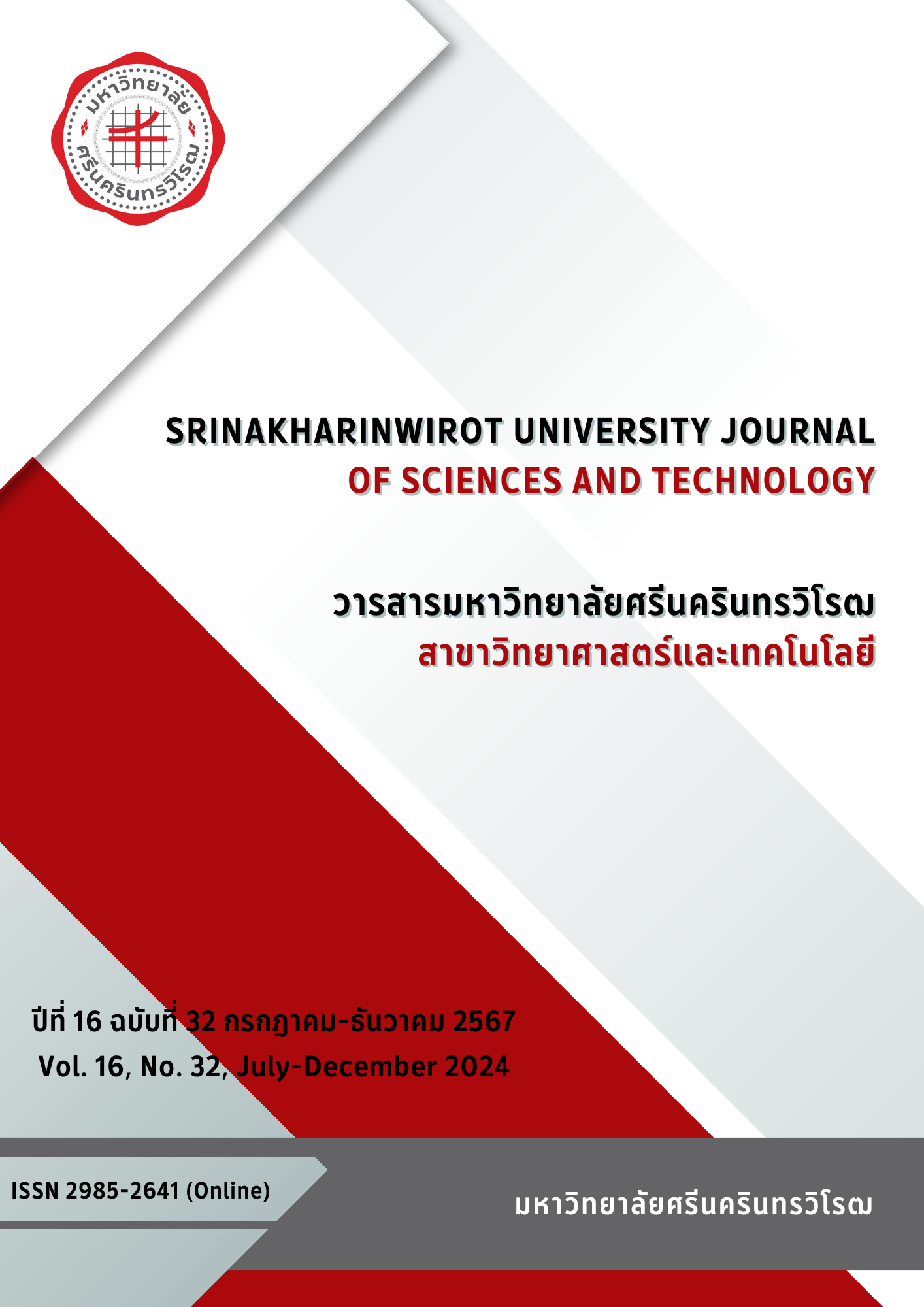การประเมินพื้นที่เสี่ยงอุทกภัยด้วยแบบจำลองซัพพอร์ตเวคเตอร์แมชชีนผ่านระบบสารสนเทศภูมิศาสตร์
คำสำคัญ:
ซัพพอร์ตเวคเตอร์แมชชีน, ระบบสารสนเทศภูมิศาสตร์, อุทกภัยบทคัดย่อ
แบบจำลองซัพพอร์ตเวคเตอร์แมชชีน หรือ Support Vector Machine (SVM) เป็นเทคนิคทางสถิติที่ใช้ในการประเมินภัยพิบัติทางธรรมชาติที่ใช้กันอย่างแพร่หลายในปัจจุบัน การศึกษานี้มีจุดประสงค์เพื่อประเมินพื้นที่เสี่ยงอุทกภัยด้วยปัจจัยเชิงพื้นที่ ที่ชี้ให้เห็นถึงความสามารถของการทำนายของแต่ละปัจจัยที่ใช้ในการวิเคราะห์ ผ่านระบบสารสนเทศทางภูมิศาสตร์ร่วมกับซัพพอร์ตเวคเตอร์แมชชีน บริเวณอำเภอเมืองอุบลราชธานีและอำเภอวารินชำราบ จังหวัดอุบลราชธานี ข้อมูลที่ใช้ในการศึกษา ได้แก่ ข้อมูลพื้นที่การเกิดอุทกภัยในอดีต แบ่งออกเป็นชุดข้อมูลการเรียนรู้และข้อมูลชุดทดสอบด้วยการสุ่มตัวอย่างกับข้อมูลปัจจัยทางกายภาพที่ส่งผลต่อการเกิดอุทกภัยในพื้นที่ศึกษา เพื่อชี้ให้เห็นประสิทธิภาพการทำนายของแบบจำลองซัพพอร์ตเวคเตอร์แมชชีนที่ชัดเจนขึ้น จึงมีการนำดัชนีความอ่อนไหวของการเกิดอุทกภัยมาใช้ในการเปรียบเทียบพื้นที่ความเสี่ยงและความถูกต้องของแบบจำลองและใช้พื้นที่ใต้กราฟ (Area Under The Curve) มาใช้ในการประเมินความถูกต้องของแบบจำลอง ผลการวิจัยพบว่า แบบจำลองซัพพอร์ตเวคเตอร์แมชชีน มีอัตราการทำนายเท่ากับ 0.8209 อัตราความสำเร็จมีค่าเท่ากับ 0.8945 และจากการวิเคราะห์ความสามารถในการทำนายของปัจจัยที่ส่งผลการเกิดอุทกภัยในพื้นที่ศึกษา พบว่าทุกปัจจัยมีความสามารถเชิงบวกต่อการทำนาย ซึ่งระยะห่างจากแม่น้ำเป็นปัจจัยที่มีความสามารถเชิงบวกสูงสุด รองลงมาเป็นปัจจัยทางด้านความสูงของพื้นที่ ความหนาแน่นของลำน้ำ ค่าการไหลสะสม และความลาดเอียงของพื้นที่จากผลการศึกษาชี้ให้เห็นว่า ซัพพอร์ตเวคเตอร์แมชชีนเป็นเครื่องมือที่มีประสิทธิภาพในการระบุตำแหน่งและแนวโน้มการเกิดอุทกภัย และการสื่อสารความเสี่ยงของพื้นที่สู่หน่วยงานที่จะเข้ามามีบทบาทในการป้องกันและบรรเทาอุทกภัย
Downloads
References
Ali, S., Cheema, M. J. M., Waqas, M. M., Waseem, M., Leta, M. K., Qamar, M. U., Awan, U. K., Bilal, M., Ur Rahman, M. H. (2021). Flood mitigation in the transboundary chenab river basin: A basin-wise approach from flood forecasting to management. Remote Sens, 13(19), Article number 3916.
Ionita, M., and Nagavciuc, V. (2021). Extreme floods in the eastern part of europe: Large-scale drivers and associated impacts. Water, 13(8), Article number 1122.
Adger, W. N. (2006). Vulnerability, global environmental change. Global Environmental Change, 16(3), 268-281.
Zerger, A. (2002). Examining GIS decision utility for natural hazard risk modelling. Environmental Modelling & Software, 17(3), 287-294.
Liu, J., Wang, J., Xiong, J., Cheng, W., Li, Y., Cao, Y., He, Y., Duan, Y., He, W., and Yang, G. (2022). Assessment of flood susceptibility mapping using support vector machine, logistic regression and their ensemble techniques in the Belt and Road region. Geocarto International, 37(25), 9817-9846.
Mojaddadi. H., Pradhan, B., Nampak, H., Ahmad, N., and Ghazali, H. B. A. (2017). Ensemble machine-learning-based geospatial approach for flood risk assessment using multi-sensor remote-sensing data and GIS. Geomatics, Natural Hazards and Risk, 8(2), 1080-1102.
Office of the National Water Resources. (2020). Lesson summary: Flood management ubon ratchathani area 2020. Office of The Prime Minister: Bangkok.
Ubon Ratchathani University. (2004). Full report: The study of flood impact in economic and environment around the moon river bank at mueang ubon ratchathani district and and warin chamrap district. Retrieved from. http://www.esanpedia.oar.ubu.ac.th/e-research/sites/default/files/UBU-2547.pdf
Tehrany, M. S., Kumar, L., and Shabani, F. (2019). A novel GIS-based ensemble technique for flood susceptibility mapping using evidential belief function and support vector machine: Brisbane, Australia. PeerJ, 2019(10), Article number e7653.
Romulus, C., and Bui, D. T. (2020). Identification of areas prone to flash-flood phenomena using multiple-criteria decision-making, bivariate statistics, machine learning and their ensembles. Science of The Total Environment, 712, Article number 136492.
Regmi, A. D., Devkota, K., Yoshida, K., Pradhan, B., Pourghasemi, H. R., Kumamoto, T., and Akgun, A. (2014). Application of flood susceptibility Index, statistical index, and weights-of-evidence models and their comparison in landslide susceptibility mapping in Central Nepal Himalaya. Arabian Journal of Geosciences, 7(2), 725-742.
Pirasteh, S., and Li, J. (2017). Probabilistic frequency ratio (PFR) model for quality improvement of landslide susceptibility mapping from LiDAR-derived DEMs. Geoenvironmental Disasters, 4, Article number 19 (2017).
Suppawimut, W. (2021). GIS-Based flood susceptibility mapping using statistical index and weighting factor models. Environment and Natural Resources Journal, 19(6), 481-493.
Tehrany, M. S., Pradhan, B., Mansor, S., and Ahmad, N. (2015). Flood susceptibility assessment using GIS-based support vector machine model with different kernel types. Catena, 125, 91-101.
Iamprakhon, B., and Charoenrak, N. (2018). A proposed method to compare areas under the ROC curves for a single dataset: A case study of credit scoring model. In University of the Thai Chamber of Commerce. Research Support Office (Ed.), 2th UTCC Academic Day (pp. 1756-1769).
Hanley, J. A., and McNeil, J. B. (1982). The meaning and use of the area under a receiver operating characteristic (ROC) curve. Radiology, 143(1), 29-36.
Dodangeh, E., Choubin, B., Eidir, A. N., Nabipour, N., Panahi, M., Shamshirband, S., and Mosavi, A. (2020). Integrated machine learning methods with resampling algorithms for flood susceptibility prediction. Science of The Total Environment, 705, Article number 135983.
Olowe, J. F. (2021). Spatial prediction of flood susceptible areas using machine learning approach: A focus on west african region [Unpublished master’s thesis]. Universitat Jaume I.
Downloads
เผยแพร่แล้ว
How to Cite
ฉบับ
บท
License
Copyright (c) 2024 วารสารมหาวิทยาลัยศรีนครินทรวิโรฒ สาขาวิทยาศาสตร์และเทคโนโลยี

This work is licensed under a Creative Commons Attribution-NonCommercial-NoDerivatives 4.0 International License.
วารสารมหาวิทยาลัยศรีนครินทรวิโรฒ สาขาวิทยาศาสตร์และเทคโนโลยี อยู่ภายใต้การอนุญาต Creative Commons Attribution-NonCommercial-NoDerivs 4.0 International (CC-BY-NC-ND 4.0) เว้นแต่จะระบุไว้เป็นอย่างอื่น โปรดอ่านหน้านโยบายของวารสารสำหรับข้อมูลเพิ่มเติมเกี่ยวกับการเข้าถึงแบบเปิด ลิขสิทธิ์ และการอนุญาต


